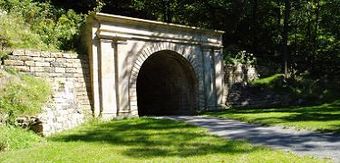Staple Bend Tunnel facts for kids
|
Staple Bend Tunnel
|
|

Staple Bend Tunnel
|
|
| Location | Mineral Point, Conemaugh Township, Cambria County, Pennsylvania |
|---|---|
| Built | 1833 |
| Architect | Sylvester Welch, J. & E. Appleton Builders |
| MPS | Allegheny Portage Railroad MPS |
| NRHP reference No. | 94001187 |
Quick facts for kids Significant dates |
|
| Added to NRHP | April 19, 1994 |
| Designated NHL | April 19, 1994 |
The Staple Bend Tunnel is a cool piece of history located near Johnstown, Pennsylvania, in a town called Mineral Point. It was built between 1831 and 1834 for the Allegheny Portage Railroad. Work on the tunnel started on April 12, 1831.
This tunnel is 901 feet (275 m) long. It was the very first railway tunnel ever built in the United States! It was dug through solid rock and then lined with strong stones. Even though it was the first railroad tunnel, it was actually the third tunnel of any kind built in the U.S. The first two were for canals, also in Pennsylvania.
Contents
Building the Tunnel: A Tough Job
Work on the Staple Bend Tunnel officially began on November 21, 1831. The workers faced really tough conditions, often dealing with bad weather.
- They worked 12 hours a day, 6 days a week.
- They were paid $13 a month, plus they got a place to sleep and food.
- These brave men chipped and blasted through 901 feet (275 m) of solid rock!
How They Blasted the Rock
To remove the rock, about 14,900 cubic yards (11,400 m3) of bedrock was blasted away using black powder. Here's how they did it:
- Workers drilled holes about three-foot (0.91 m) deep into the rock.
- Drilling just one hole could take up to three hours for a team of three men.
- They would drill about nine or ten holes, each one inch (25 mm) wide and 36 inches (910 mm) long.
- Then, they'd push about One pound (0.45 kg) of black powder, wrapped in paper, into each hole.
- They'd pack it down, poke a hole with a sharp needle, and add a fuse.
- Fuses were lit right before mealtime. This way, the explosions would happen while workers ate.
- After the dust settled, they'd go back to work, cleaning out the blasted rock.
- Each blast only removed about 18 inches (460 mm) of the rock from the 36-inch deep hole.
Connecting the Tunnel Ends
The tunnel grew by about 18 inches (460 mm) each day, with workers digging from both ends toward the middle. On December 21, 1832, the two sides finally met! Everyone celebrated with speeches and toasts. The entire tunnel excavation was finished by April 1833.
Fancy Entrances
The ends of the Staple Bend Tunnel were lined with carefully cut stone. This was important for safety, as it prevented rocks and dirt from falling due to rain or the trains passing through. The entrances were also designed to look very impressive to travelers. They were built in a "Roman Revival style," which means they looked like old Roman buildings.
Building these fancy entrances cost almost half of the total project budget of $37,498.85! After some years, the Allegheny Portage Railroad, including the tunnel, was sold to the Pennsylvania Railroad in 1857.
What Happened After the Railroad?
In 1907, a writer named Henry Storey mentioned that the east entrance of the tunnel had been taken apart. The stones were used for other buildings, but he didn't say which ones. Luckily, the west entrance still stands and has been fixed up to look grand again.
After the old Portage Railroad stopped using the tunnel, it found new purposes:
- It became a popular route for horse-drawn carriages.
- This changed after the terrible Johnstown Flood in 1889. The flood caused damage, making the tunnel less ideal for driving.
- Even so, local people continued to visit the tunnel, and even went on dates there, until the 1940s!
In the 1940s, the Manufacturer's Water Company took over the tunnel. They added a concrete lining to the east side and installed large water pipes and a water storage area. The tunnel was then closed to the public. The water lines were used by Bethlehem Steel, a big steel company.
The Staple Bend Tunnel was recognized as a National Historic Landmark in 1994. In 2001, it became part of the Allegheny Portage Railroad National Historic Site, which is managed by the National Park Service. To make it safe for visitors, new rock bolts, support posts, and mortar were added. Today, the tunnel is open to the public as part of the Staple Bend Tunnel Trail, where you can walk or bike through history!
Gallery







